The objective of this report is to identify the effectiveness of implementing the loyalty card marketing strategy for Pastas R Us, Inc. Furthermore, it is essential for the organization to determine feasible and actionable opportunities that may require improvement. These objectives are evaluated by this report to ensure that decisive actions are undertaken (Sarstedt & Mooi, 2018). The nature of the current database involves records such as square feet, average spending per person, percentage sales growth of the previous year, percentage of loyalty card program sales, and annual sales per square feet. Other significant records include medium income, medium age, and bachelor’s degree percentage. These variables are used in the database of this organization because they provide information regarding customers’ age, income, company sales, and growth. The metadata are organized in tables which keeps the company’s records using constraints such as primary and foreign keys.
From table 1 below, Sales/Person, SalesGrowth%, LoyaltyCard%, Sales/SqFt, MedIncome, MedAge, BachDeg%, and Annual Sales reported a mean of 7.044, 7.414, 2.026, 420.305, 62807.703, 35.201, 26.311, and 1059381.314 respectively. The same variables reported a standard deviation of 0.297, 6.625, 0.552, 137.240, 17904.273, 3.655, 7.005, and 280423.448. The above descriptives provide a simple way of interpreting Pastas R Us, Inc data (Vetter, 2017). Figure 1 below shows the composition of the mean and the standard deviation.
Table 1: Descriptive statistics
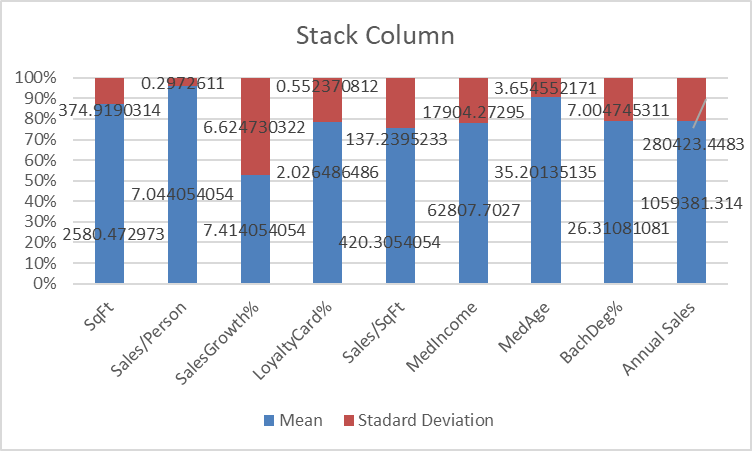
Analysis
The regression equation for BachDeg Vs Sales/SqFt is Sales/SqFT = BachDeg + e. MedIncome vs Sales/SqFt regression line is Sales/SqFT = MedIncome + e. MedAge vs Sales/SqFt regression equation is Sales/SqFT = MedAge + e. The regression equation for LoyaltyCard(%) vs SalesGrowth(%) is SalesGrowth(%) = LoyaltyCard(%) + e. Figure 2, 3, 4 and 5 below shows scatter plots of the above regression equations.
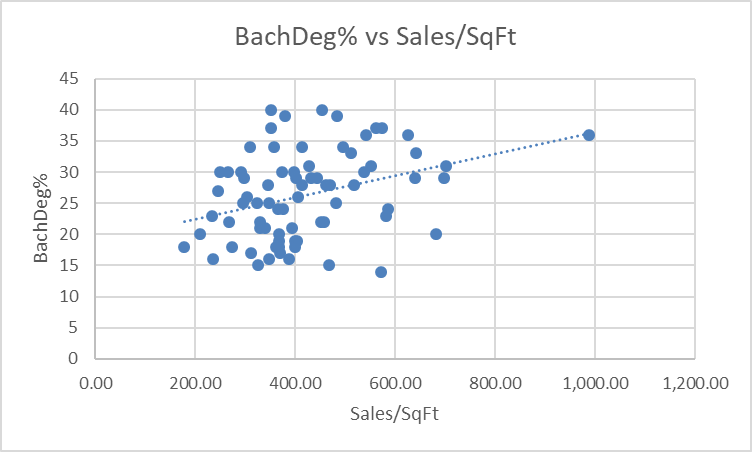
Figure 2 above scatter plot shows an increasingly positive relationship between the sales/SqFt and the BachDeg %. This implies that the higher the percentage of the bachelor’s degree, the higher the sales per sq. ft. However, the above data has outliers which may result in changes in the relationship between the two variables, leading to misleading interpretations.
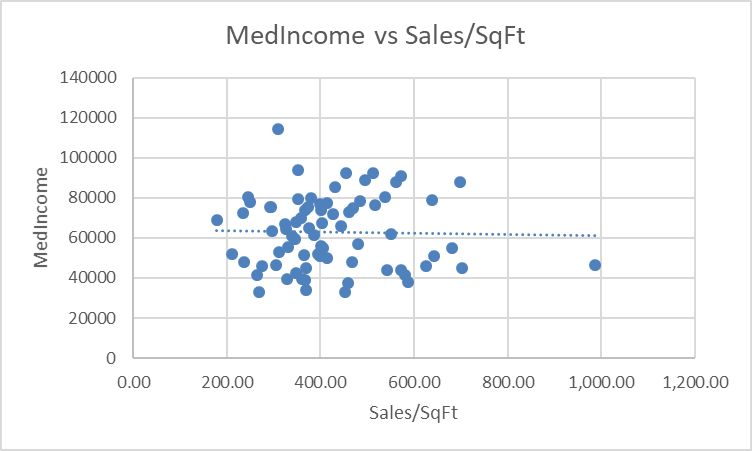
Figure 3 above scatter plot shows no relationship between MedIncome and Sales/SqFt. This implies that it is impossible for the company to identify whether MedIncome has a positive or negative effect on the sale per sq. ft. The variable portrays no relationship between the two; hence it is ineffective to identify the impact of the independent variable MedIncome. The above data also has outliers which alter the results.
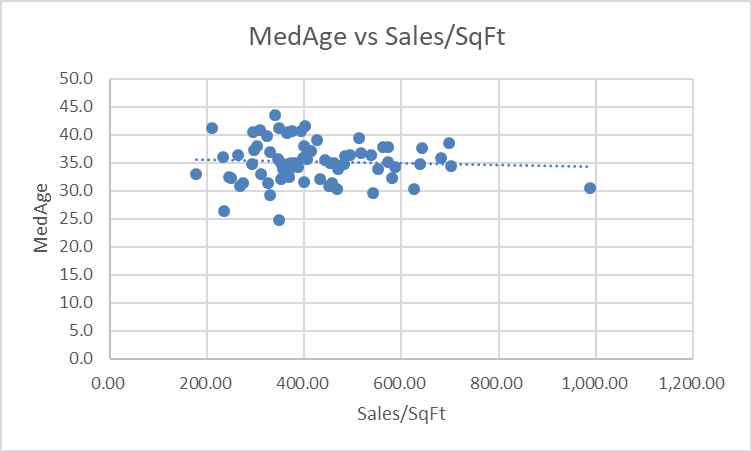
Figure 4 above shows no relationship between Median age and Sales/SqFt. It is impossible to identify the effect of the independent variable Median age on the dependent variable Sales/SqFt. Therefore, it portrays that the Median age has no significant predicting value to the Sales/SqFt.
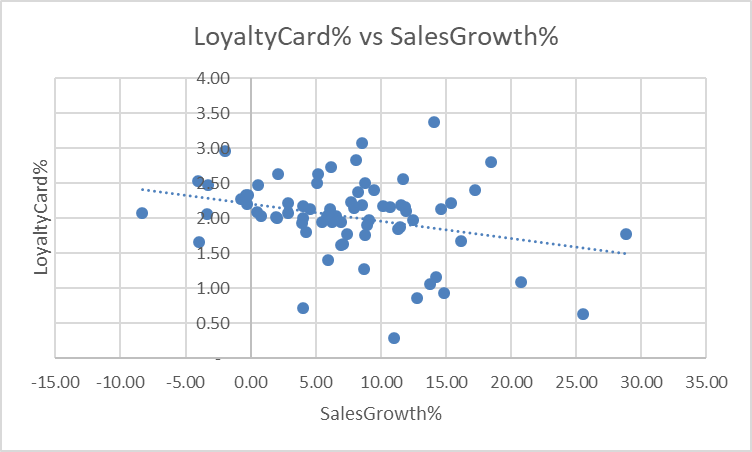
Figure 5 above shows that loyaltycard% and salesGrowoth% have a decreasing negative relationship. This implies that loyalty card has a negative outcome on the growth of sales. The use of loyalty cards is reducing the sales growth rate of the organization.
Recommendations and Implementation
BachDeg% and Sales/SqFt is the most effective expansion criteria because it is the only criterion that has portrayed an increasingly positive relationship. This shows that its application leads to increase sales per sq. Ft of the company. It should be considered because it is beneficial to the organization. The median age between 25 – 45 years criterion should be changed to age groups that categorize clients with an age range of five or four years. This will help identify the specific group that has a significant effect on sales/SqFt. Using the median age of 25 – 45 is an extensive range, making it very difficult to identify the impact.
The findings show that loyalty card is negatively correlated with sales growth. Therefore, changing this marketing strategy is necessary as it affects the organization’s growth. It is essential to select a method that leads to positive effects on the growth of sales as it has a significant impact on the Pastas R Us, Inc. cash flow. The company can lower the cost of noodle-based dishes to attract the youths (Melović et al., 2020). This provides the company with a cost-differentiation business strategy which may be useful in increasing the company’s sales growth. Tracking the effectiveness of the cost differentiation strategy requires collecting records such as overall sales of the product and customers’ attitudes regarding the cost and quality of the product. This information can be collected through sample surveys using google forms.
References
Melović, B., Jocović, M., Dabić, M., Vulić, T., & Dudic, B. (2020). The impact of digital transformation and digital marketing on the brand promotion, positioning and electronic business in Montenegro. Technology in Society, 63, 101425. Web.
Sarstedt, M., & Mooi, E. (2018). Descriptive statistics.Springer Texts in Business and Economics, 91-150. Web.
Vetter, T. (2017). Descriptive statistics.Anesthesia &Amp; Analgesia, 125(5), 1797-1802. Web.